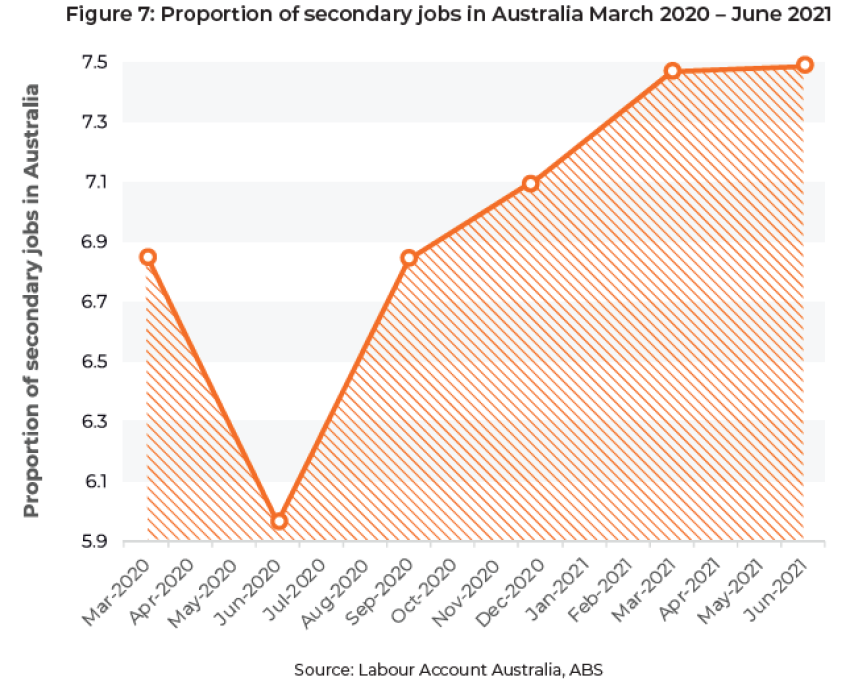
A new report by the Australian Council of Trade Unions (ACTU) said a record number of people are now working more than one job.
The report, Breaking point: The rise of working more than one job, released in September, stated that poor pay, a lack of hours and employer responses to the pandemic are driving insecure work.
After two years of pandemic lockdowns and new industrial laws that allow bosses to declare a worker is casual, it found that half the workforce is in insecure work.
Bosses responded to the pandemic by demanding workers be more flexible. The Australian Bureau of Statistics’ (ABS) Labour Account Australia for June 2021 showed 867,900 people were working two or even three jobs, as the Eastern states re-entered lockdowns. Of those, a record 209,100 workers were working three or more jobs, 10.4% more than 2020.
Two out of every five new jobs created in the first half of the year were for people holding multiple jobs. There has been a rise of more than 245,000 workers in multiple jobs since June last year. Of the 867,900 working more than one job this June, 55% were under the age of 35 and 53% were women.
All industries, except mining, recorded a rise in multiple jobs since June last year. The largest were in administrative and support services (108,500 jobs) and the biggest occupations were commercial and domestic cleaners, security guards and call centres; health care and social assistance (36,200 jobs); accommodation and food services (23,600 jobs); and education and training (22,000 jobs).
The ACTU report said low wages is one driver of this trend. ABS data over 2016–17 showed the median annual income for those working multiple jobs was $40,000, whereas those working one job eared $49,083.
Of those holding multiple jobs, women earned a median annual income of $36,500, whereas men earned $46,200 — a substantial difference.
Nominal wages have barely kept up with rises in consumer prices for eight years (since 2013). This means that “real” wages, adjusted for inflation, have stagnated and people holding multiple jobs with incomes below that of workers on a “good” wage have gone backwards.
The May budget predicted that a quarter of a percentage point fall in real wages in 2021–22 and zero growth in 2022–23 and 2023–24. It also predicted a quarter of a percentage point rise in real wages in 2024–25. This amounts to no real wage growth for those on “good” wages in single jobs for the next four years.
It also means that wages for workers working multiple jobs, on smaller annual incomes across all jobs, will continue to be eaten away by rises in consumer prices predicted to rise by 1.75% (2021–22), 2.25% (2022–23), 2.5% (2023–24) and 2.5% (2024–25).
Another driver of insecure work, the ACTU said, is employers giving new staff insecure work deals, using the pandemic as an excuse.
Despite the largest growth of workers working multiple jobs being in administrative and support services, their pay only rose by 1% to June. By contrast, average wage growth was 1.7%.
The number of jobs in health care and social assistance rose by 36,200 to a total of 138,400 but, again, these workers had to work across a number of locations. During the pandemic, they were more likely to transmit the virus, as was shown in the aged care sector in Victoria.
Holding down multiple jobs in a country with the third highest non-standard forms of work in the Organisation for Economic Cooperation and Development illustrates growing employment insecurity.
The shift towards part-time and casual work also highlights the impact of stagnant household incomes. The federal government has exacerbated this by making it easier for bosses to deem an employee casual, regardless of their work.
The ACTU report put the rise in workers working multiple jobs down to the erosion of the “standard employment relationship” of full-time paid jobs with “normal leave entitlements”, the rising share of casual jobs and the growing involuntary part time work and growing self-employment.
The Centre of Future Work said “standard” employment jobs fell in 2017 to below a 50% share of all jobs for the first time in recorded statistics. At the end of last year, only 50.5% of all jobs were permanent full-time paid jobs with leave entitlements. As a result, the report said, “half of all employed Australians now confront one or more key dimensions of insecurity in their work (casual, marginal self-employment)”.
It blamed the business model that has shifted economic risks from the employer to the worker. When the economy falters due to a recession or financial crisis, “it is labour, not capital, that absorbs most of the pain”. Because of the very high proportion of insecure jobs, employers can “rapidly and substantially reduce their labour input and labour costs in a downturn”. It also means that, in good economic times, capital reaps the rewards, not labour.
The pointed out that the labour share of national income is in a steep decline due to stagnant wages and the expansion in non-standard employment. By contrast, it said, the profit share of national income has “increased significantly”.
The ACTU report is based on ABS labour force data collected before the latest lockdowns. It said it is therefore highly likely those working multiple jobs will be the most likely to lose work first.
It warned that in the post-lockdown economic recovery “there will be yet another record-breaking surge in Australians working more than one job, and at breaking point … unless the Federal Government and employers change course”.